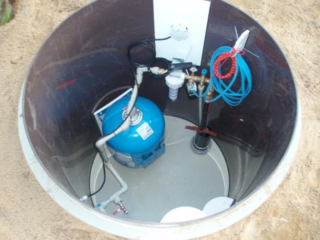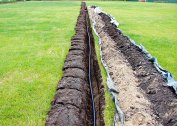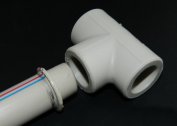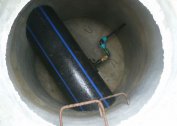Do-it-yourself winter water supply from the well to the house is one of the options for constructing an autonomous water supply system that can be used year-round. The peculiarity of such a highway is that the water supply is laid in special trenches located below the level of freezing of the soil, and insulated.
Options for arranging a water supply system from a well in a country house in winter
Winter water supply is needed at the cottage or garden in case you plan to use the system throughout the year. An autonomous station has a large number of advantages, the main ones are:
- A submersible or surface pump station can be used. The choice, as a rule, depends on the depth of water in the source.
- With proper drilling and well arrangement, the source has excellent composition and taste characteristics of well water.
- The water supply system is completely autonomous, for example, if electricity is turned off at the cottage, you can get water manually.
- You can take care of the source yourself, there is no need to attract specialists whose services cost a lot of money.
If the arrangement of the source was carried out according to all the rules, the water supply system and the source itself will serve its owners for many years.
Winter water supply of a summer residence from a well with temporary residence in winter can be equipped in one of two ways:
- Lay the pipe system above the freezing depth of the soil, but at the same time warming it.
- Lay the pipeline in trenches below the freezing depth of the soil.
Each method has both advantages and disadvantages, so before laying the pipeline you need to carefully familiarize yourself with the features of the arrangement methods.
Laying pipes below the freezing depth of the soil
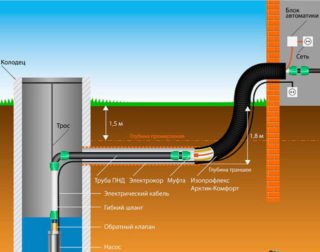 It is advisable to use this method only if the depth of soil freezing does not exceed 1.5 meters. This is the most budgetary and easy to implement method, however, it also has drawbacks.
It is advisable to use this method only if the depth of soil freezing does not exceed 1.5 meters. This is the most budgetary and easy to implement method, however, it also has drawbacks.
Most often, difficulties arise with the choice of pipes: low-pressure polyethylene pipes cannot be used, since the mass of soil will lead to cracking of the material, and the metal will corrode. Other disadvantages:
- When installing the system, a large number of earthwork is required.
- Difficulties in finding damaged sections of the autonomous highway.
- If the depth of the trench is less than the level of freezing of the soil, the probability of damage to the integrity of the pipeline increases significantly.
To minimize the likelihood of a leak, it is necessary to make as few joints between the pipes as possible at the construction stage.
Water system insulation
Resorting to this method, the pipeline is mounted at a depth of 0.4-0.6 m, while it is insulated in the trench.
For the northern regions of Russia, it is recommended to trench the trenches with cellular blocks of concrete or bricks. This approach will increase heat conservation. Implementation will require considerable financial investments, but this will exclude 100% chance of freezing pipes.
When constructing a water supply system, two types of insulation are used:
- Soft heat-insulating materials.
- Hard heat-saving shells.
When choosing a material, you need to pay attention to technical characteristics, resistance to mechanical and physical influences, cost, as well as ease of use.
Preparatory work
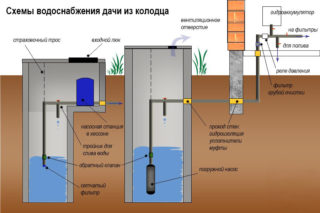 Before proceeding directly to the installation of the pipeline network, you need to familiarize yourself with the sequence of work performed and draw up a project, purchase high-quality equipment and appropriate tools.
Before proceeding directly to the installation of the pipeline network, you need to familiarize yourself with the sequence of work performed and draw up a project, purchase high-quality equipment and appropriate tools.
Design allows you to solve the following problems:
- For proper planning of an autonomous water supply system in a country house or cottage, it is necessary to take into account the operational parameters and requirements for the communication network.
- It is important to analyze the total volume of water consumption and the number of its individual nodes.
- Based on the data obtained in the first two paragraphs, we can begin to draw up a water supply scheme in the country.
Only after completing all the preparatory work can you start choosing pumping equipment, pipes and other parts.
Necessary tools and materials
The following equipment is purchased for the installation of a water supply system that can be used throughout the year:
- Submersible or surface pump, pump station.
- Cable for power supply of the pumping station.
- Pipes for laying the path from the well to the house.
- Fittings and valves.
- Control automation (if the equipment is not equipped with automatic components).
When equipping a water supply system in a summer cottage, it is recommended to give preference to pumping stations or a submersible pump installed directly in the well shaft. This approach is due to the fact that the equipment will be located below the level of soil freezing with the advent of winter.
If the surface pump is located in an unheated room during the winter, the remaining water in the pipeline will freeze, which will damage the entire system.
Installation Steps
It is necessary to begin the arrangement of water supply with the design of the system, the preparation of drawings. The diagram should clearly depict the paths that water will make from the water intake point to the wiring places in the house.
The branching of pipes in the room can be performed in several ways:
- Collector - a separate pipe is supplied to each point of water intake.
- Sequential - the entire pipeline is installed along the entire building and several branches depart from it to the points of water intake.
It is recommended to resort to the latter method if the volumes of the consumed water resource are small and no more than three people live in the house.
If a washing machine and dishwasher are installed in the building, there are watering hoses and more than three people live, it is better to install a collector water supply system that can create optimal pressure in the water column and provide good pressure from the tap.
Stages of installing a winter water supply:
- System design. Selection and purchase of equipment and materials.
- Preparation of trenches for pipes. A layer of sand and gravel is compacted at the bottom of the recess.
- Installation of pumping equipment, hydraulic accumulator.
- The connection of the pumping station, the accumulator with the pipe.
- Insertion of the intake pipe into the well shaft.
- Installation of insulated pipes from the well to the cottage.
- The layout of the autonomous water supply system indoors.
Installation of the pipeline is carried out using special overhangs - these are special short pipes with threads on both sides. It is pressed to the pipes by fitting adapters or flanges.
To prevent leaks, it is necessary to carefully process the joint of parts with sealant. Polyethylene pipes are connected using fittings or soldering. In addition, adhesive joints are treated with silicone sealant. It is strictly forbidden to use bitumen and mastic.
The cost of laying a winter water supply for a summer residence depends on the area and model of pumping equipment. The average price ranges from 15,000 to 20,000 rubles.
